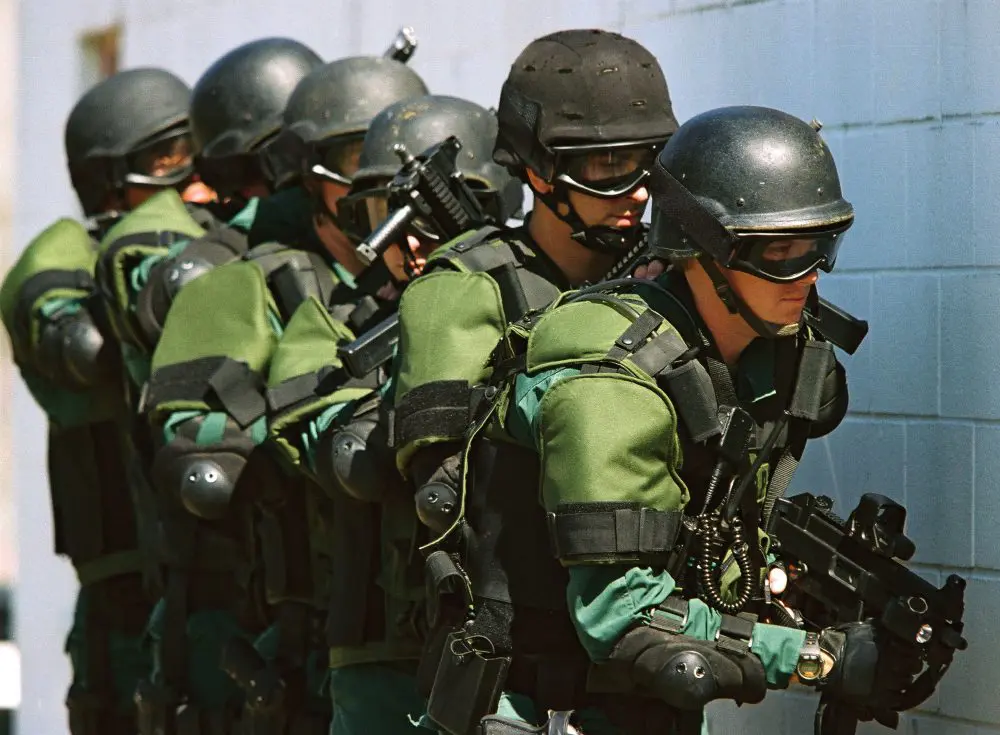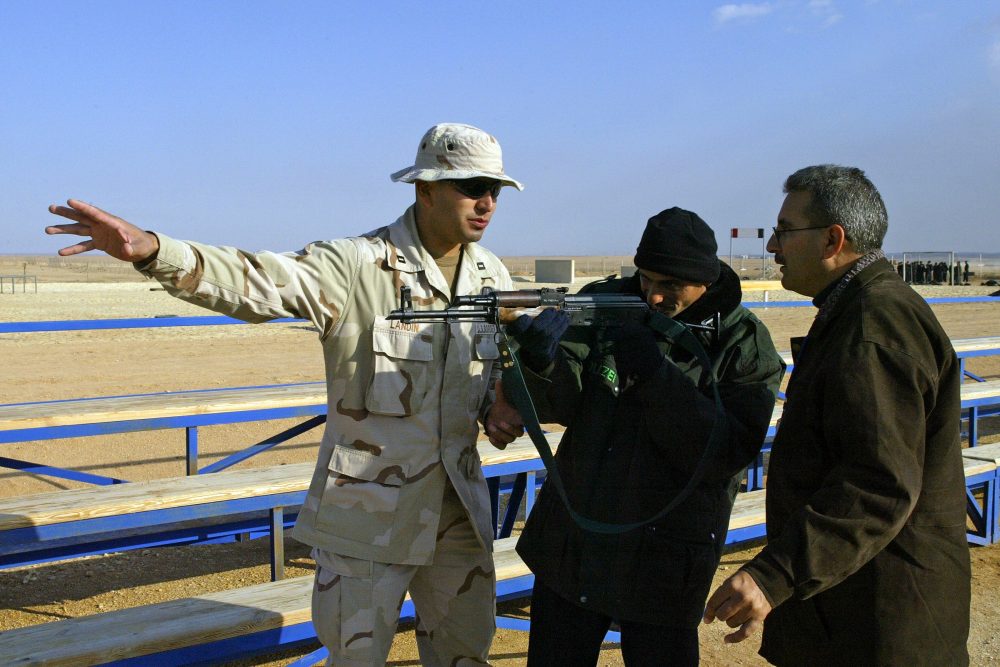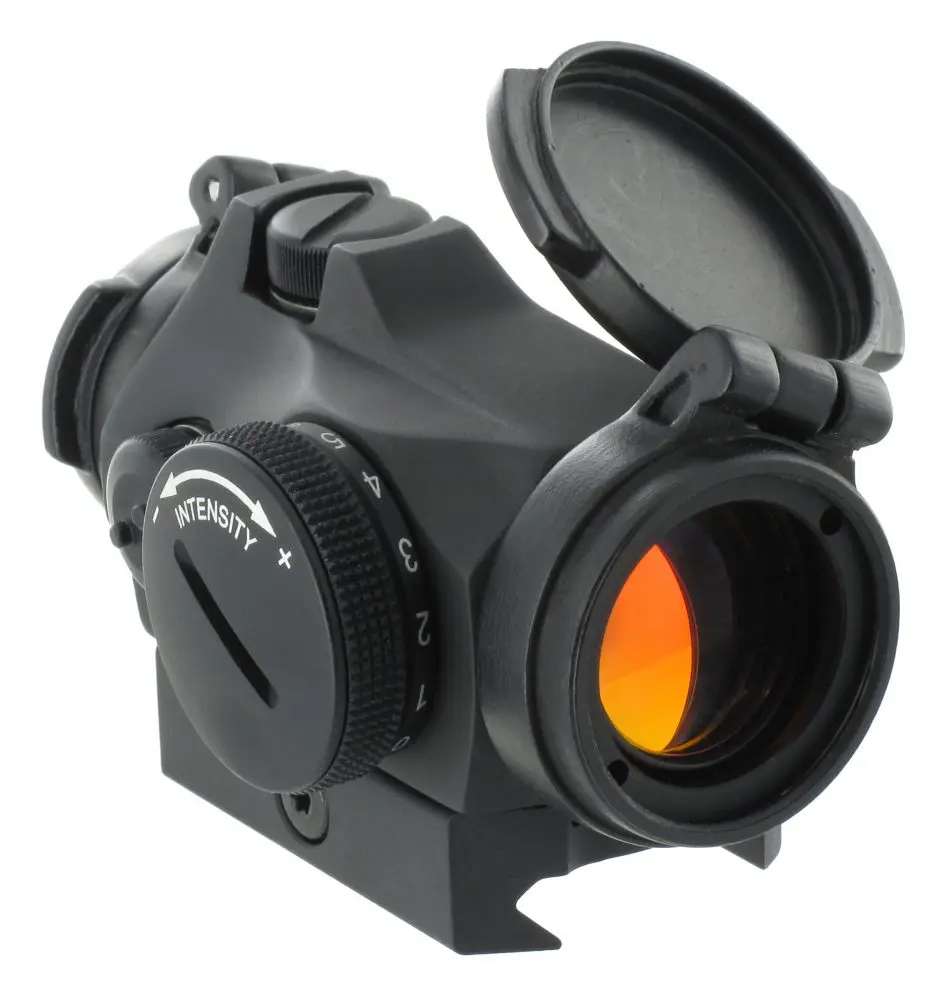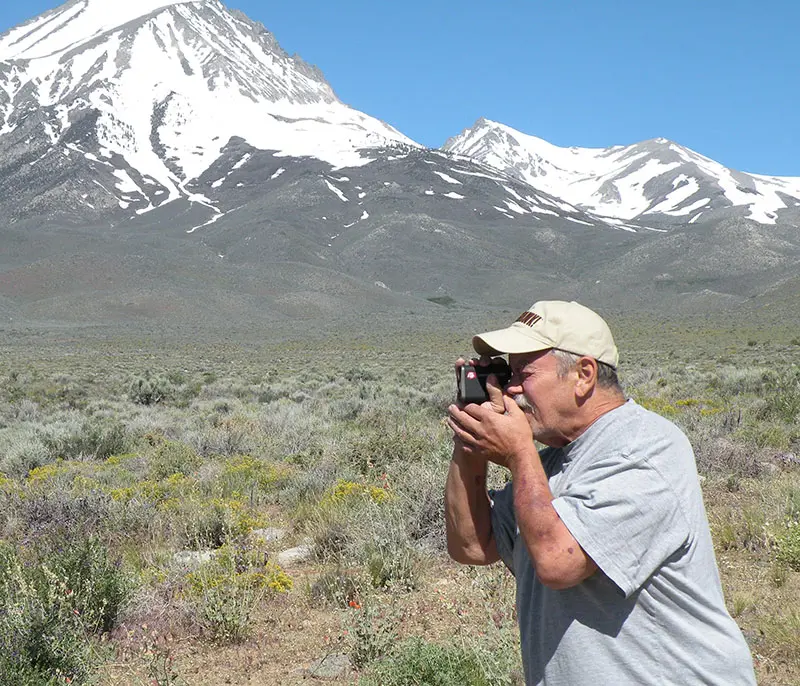The U.S. Border Patrol Tactical Unit, known by the acronym BORTAC, is the international special operations force of the U.S. Department of Homeland Security’s Bureau of Customs and Border Protection (CBP). BORTAC and its specialist operators carry out some of the most demanding and dangerous missions that fall under the jurisdiction of CBP. These missions include tracking and intercepting illegal immigrants, drug smugglers and terrorists. BORTAC also responds to disasters and critical incidents and provides support and training to domestic and foreign government agencies.
BORTAC advisor instructs Iraqi Border Police trainee in rifle Marksmanship. One of BORTAC’s international missions is to train and support foreign law enforcement agencies. Photo: Gerald Nino/DHS
Table of Contents
History and Missions
The Border Patrol was originally an agency of the U.S. Department of Justice and constituted the uniformed division of the Immigration and Naturalization Service (INS). Border Patrol officers were charged with patrolling 7,000 miles of land border shared with Mexico and Canada and 2,000 miles of coastal waters surrounding southern California and the Florida peninsula. In the 1980s, a rise in the threat of organized drug crime and mass migrations from Cuba further challenged the Border Patrol. BORTAC was formed in 1984 in response to a number of riots and hostage-taking incidents at INS detention facilities. The Border Patrol recognized the value of having a highly trained mobile response force capable of employing special weapons and tactics.
Having now been in existence for over 20 years, BORTAC has a proven record of successfully carrying out difficult assignments. Since its inception, BORTAC has been heavily engaged in the war on drugs, both domestically and abroad. BORTAC operators have participated in counter-drug missions around the world. During various multi-national assignments, BORTAC has worked with many U.S. and foreign law enforcement agencies, including the Drug Enforcement Administration, Department of State, and military forces to stem the production and distribution of illegal drugs. On the home front, BORTAC has conducted a number of operations to identify, track and apprehend drug traffickers on both the Mexican and Canadian borders.
Border Patrol Agents practice dynamic entry skills. BORTAC often utilizes Heckler & Koch UMP chambered in .40 S&W, seen here equipped with EOTech sights, for CQB work. Photo: James Tourtellotte/DHS
BORTAC continues to respond to INS detention centers and assist the Federal Bureau of Prisons at their facilities. After more than 100 hostages were taken during the 1987 riots at the Federal Penitentiary in Atlanta, BORTAC (along with various other tactical units) responded. After a standoff lasting 11 days, the incident was peacefully resolved through negotiations. In 1992 BORTAC joined other federal special operations units, including the U.S. Marshal Service Special Operations Group and the Federal Bureau of Investigation Hostage Rescue Team, in deploying to Los Angeles in response to riots that resulted from the acquittal verdict of the Los Angeles Police Department officers charged in the Rodney King incident.
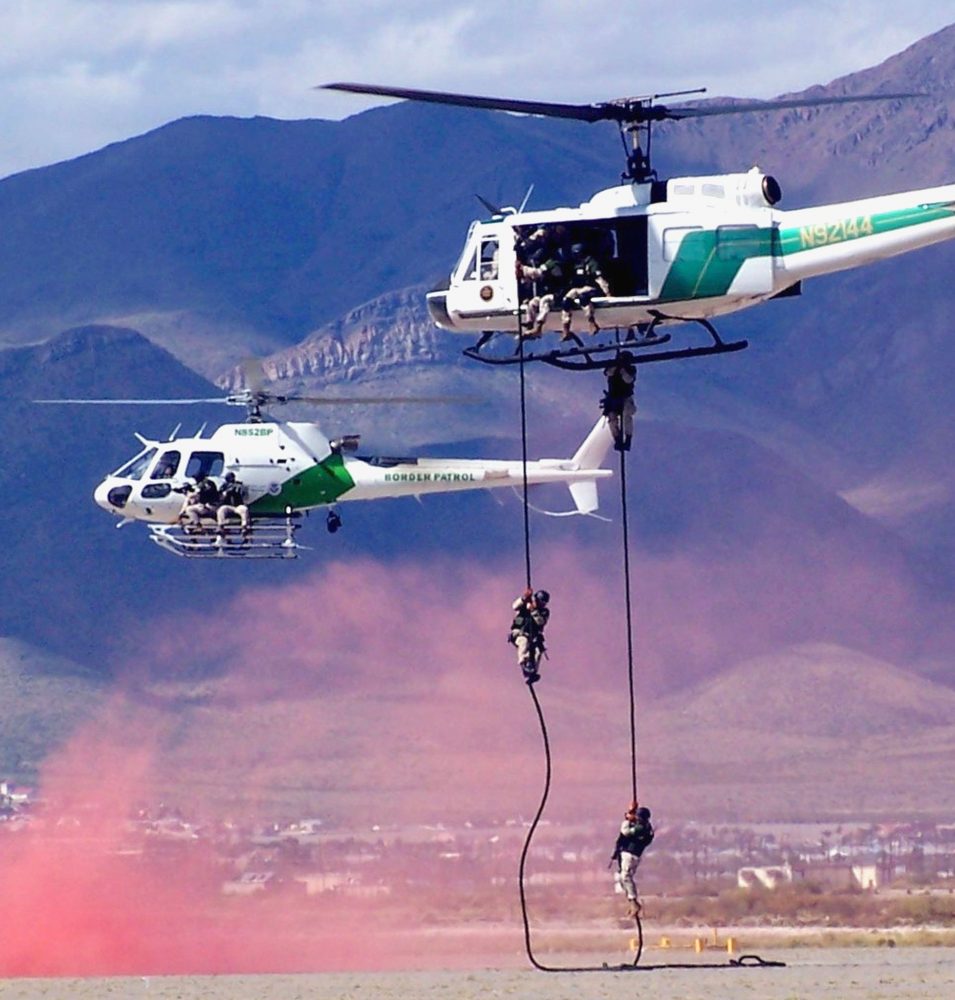
BORTAC has also provided vital support during special events and disaster relief. For example, operators have regularly assisted with security and crowd management at major national proceedings such as Presidential inaugurations and political rallies, and with sports events such as the Super Bowl and the Winter Olympics in Salt Lake City. In 1995, after the U.S. Virgin Islands were ravaged by Hurricane Marilyn, BORTAC provided security for relief personnel and helped restore order. More recently BORTAC provided aid to Gulf Coast residents in the aftermath of Hurricane Katrina. Operators assisted local and state agencies with law enforcement duties and aided in the search for victims.
Higher Public Profile
For the first 16 years of its existence, BORTAC operated in relative obscurity outside the realm of the special operations community, until it became the focus of international media attention in 2000. In late 1999 a six-year-old boy named Elian Gonzalez left Cuba aboard a small boat in the company of his mother and nine others attempting to seek asylum from the regime of Communist dictator Fidel Castro. Tragically, everyone except Elian Gonzalez perished when the boat capsized in the Florida Straits. Fishermen found Gonzalez floating on an inner tube and took him to Florida, where he was taken in by relatives. A great controversy ensued over the child’s immigration status and whether he should be repatriated back to his father, who was still living in Cuba.
U.S. Immigration officials and the U.S. Attorney General determined that Gonzalez should be returned to the custody of his father in Cuba. U.S. relatives of the child and anti-Castro activists were outraged by the decision. Gonzalez was kept secluded in a Miami residential community by his relatives, and the house was ringed with angry activists and protestors. BORTAC was tasked with planning and executing an entry operation into the home to extract Gonzalez. On 22 April 2000, BORTAC operators entered the now-barricaded home while receiving a barrage of rocks and bottles thrown by the protestors outside. Gonzalez was safely removed and eventually returned to his father’s custody. The media attention was mostly political in nature, but it did reveal to the world that BORTAC could execute a difficult tactical operation with minimal violence and no casualties.
The coordinated September 11 terrorist attacks upon the United States resulted in a heightened level of activity and important organizational changes for BORTAC. In order to provide extra security in the wake of the attacks, BORTAC elements were deployed across the country to various locations that were potential targets. Intense operations to interdict the entry of terrorists across the nation’s borders and sea frontiers were also carried out. Operational control of the Border Patrol was passed from the Department of Justice to the newly formed Department of Homeland Security (DHS). The Border Patrol, including BORTAC, became part of the newly formed Bureau of Customs and Border Protection. CBP also absorbed elements of various other agencies, such as portions of the U.S. Customs Service from the Department of Treasury.
Border Patrol Agents receive specialized training and equipment for countering various threats, potentially even nuclear, biological and chemical agent attacks. Photo: James Tourtellotte/DHS
Headquarters
BORTAC headquarters is located at Biggs Army Air Field near El Paso, Texas. Personnel assigned to the headquarters include the unit Commander, Deputy Commander and several Tactical Team Leaders. Civilian administrative staff and support personnel are also based at HQ. The individual BORTAC operators who make up the rank and file membership of the unit are scattered around the United States. BORTAC operators, until called upon for specific BORTAC duties, serve in various assignments in field offices across the Border Patrol’s 20 operational sectors. For security reasons CBP will not release the total number of personnel assigned as BORTAC operators.
Rigorous Qualification Process
All BORTAC members are volunteers and are recruited from within the Border Patrol. In order to apply, candidates must have a minimum of three years continuous service with the Border Patrol. Candidates must also pass an oral interview and meet minimum standards on the agency’s physical fitness and firearms qualification tests. The current standards consist, in part, of obtaining a 90% score or higher on the Border Patrol Physical Efficiency Battery and scoring a minimum of 324 out of a maximum of 360 points on the pistol qualification course.
BORTAC operators armed with Colt M4A1 carbines conduct building search in New Orleans for potential victims and looters in aftermath of Hurricane Katrina. Photo: Gerald Nino
After candidates pass the screening process, they must attend the four-week BORTAC Selection Course. The selection course is extremely difficult and both physically and mentally demanding on candidates. Reportedly there is a high drop-out rate among attendees. The majority of the training is conducted at the arid McGregor Range Complex, located in Oteso County, New Mexico. The course of instruction includes land navigation, patrolling, immediate action drills, close quarters combat, defensive tactics, medical skills, helicopter operations and extensive firearms training. Between 1984 and 2007, BORTAC has conducted 21 Basic Selection schools, with graduation rates averaging between 10 and 20 operators per class.
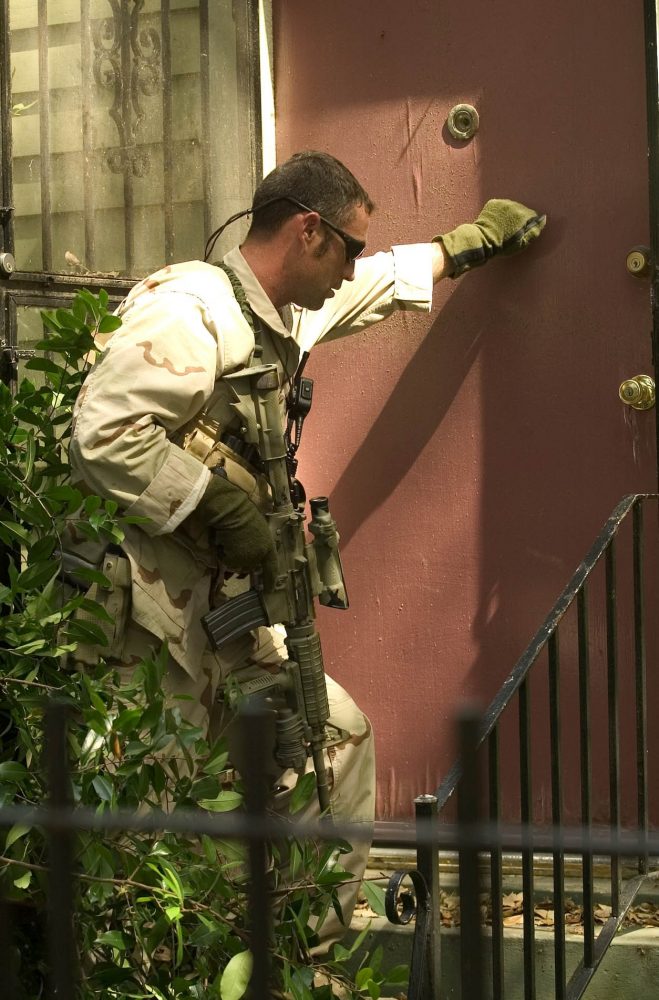
Upon successful completion of the course, graduates are awarded the coveted BORTAC tab, which is worn above the Border Patrol uniform patch on field uniforms. After graduation, new BORTAC members receive additional internal training before becoming fully qualified operators. BORTAC operators routinely participate in joint training with other domestic and foreign law enforcement and military units. BORTAC also utilizes training from commercial vendors in order to stay current with tactical trends.
Weapons and Gear
BORTAC operators have a wide variety of equipment and firearms at their disposal. For tracking and surveillance purposes, they are outfitted with a mixture of optical, night vision and thermal imaging instruments. Other items such as ballistic shields, breaching tools and other entry kit are also issued. The standard sidearm is the Heckler & Koch USP Compact pistol, chambered in .40 S&W. Colt M4A1 carbines are the standard rifle, and the Remington 870 is the standard shotgun. For entry team use, the Heckler & Koch UMP submachine gun in .40 S&W caliber is issued. Snipers, known in BORTAC as Primary Marksmen/Observers, use the Remington 700 LTR as their primary rifle. For chemical munitions and less lethal applications, BORTAC employs the Heckler & Koch model 69 40mm grenade launcher.
BORTAC’s Future
BORTAC members currently remain on standby to respond to critical incidents and other contingency operations. Depending on the specific needs of any given operational scenario, one or more BORTAC teams can be deployed in response. A team can also be broken down into smaller squads if appropriate. BORTAC is regularly deployed to alien and drug smuggling hotspots along the U.S. border. BORTAC man-tracking skills and patrol tactics dramatically increase offender apprehensions in sectors where they operate. BORTAC operators also continue to support multinational drug enforcement operations and play a role in training Iraqi Border Police officers at locations in the Middle East. It is obvious that BORTAC will continue to have a high operational tempo on both the domestic and international fronts for the foreseeable future.
The author would like to thank the BORTAC Headquarters staff and DHS public affairs for their assistance in producing this article.
